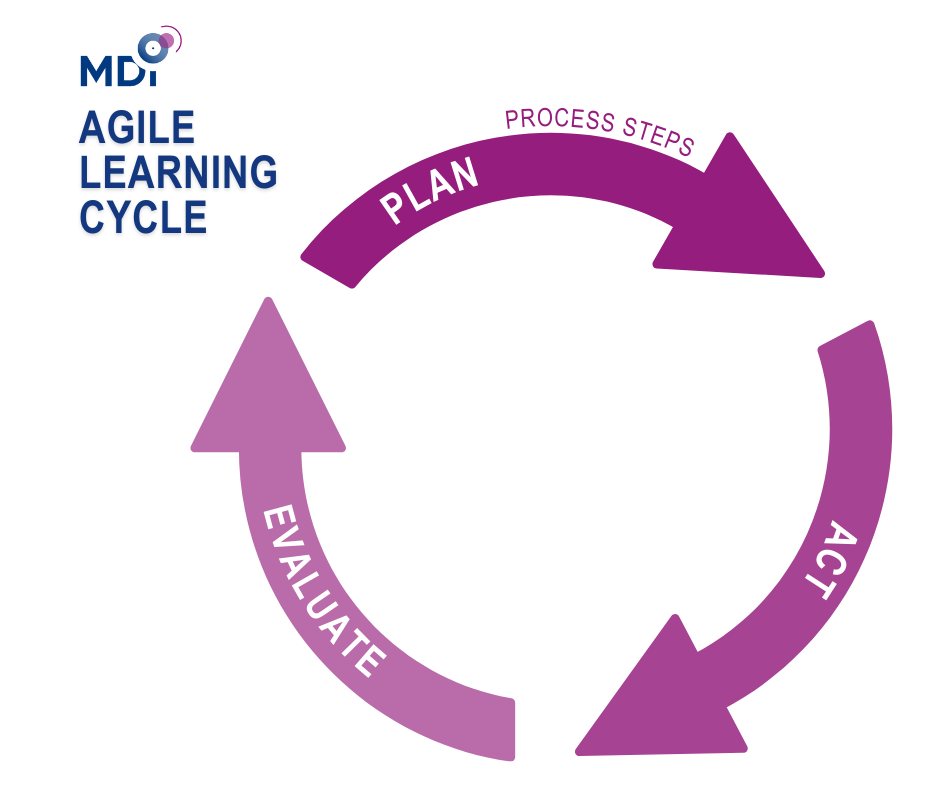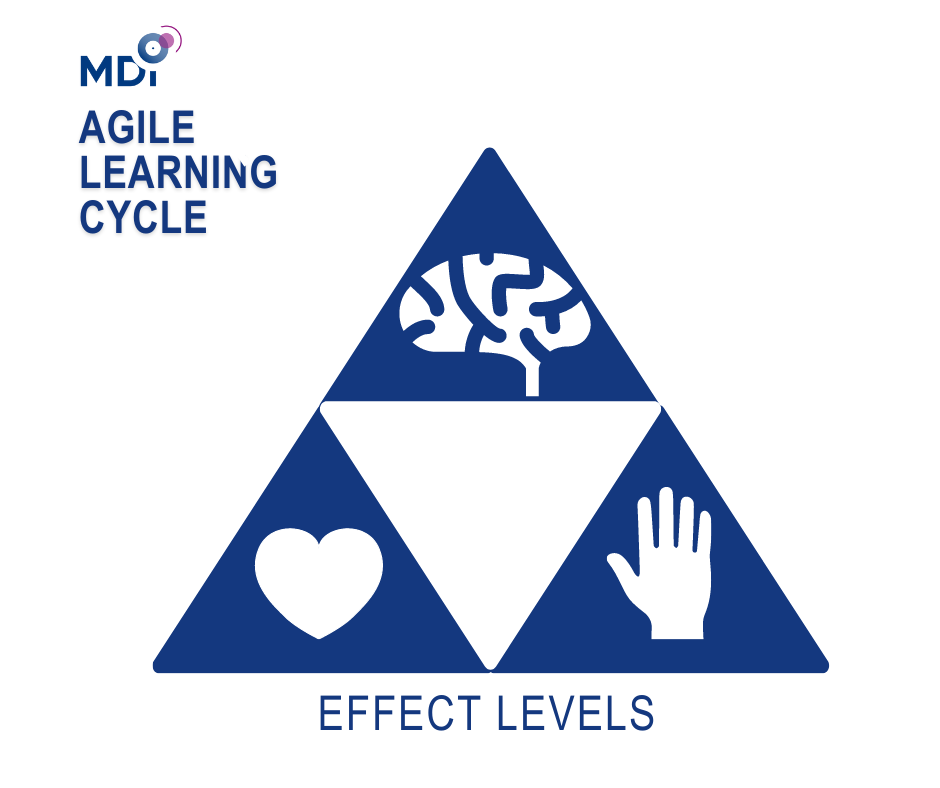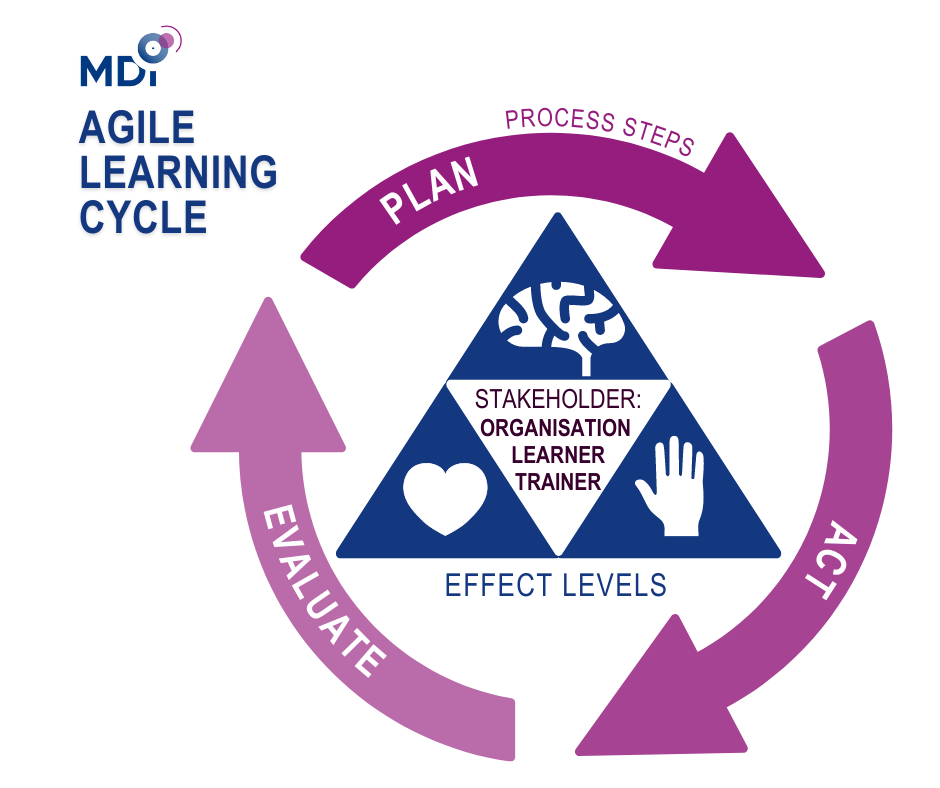What is the reality of learning in large companies today?
We often see in a wide variety of companies that there is a department that is single-handedly responsible for designing training programs, then planning them through from A to Z in advance, with a strong focus on teaching abstract models.
What’s the problem with that? Firstly, the work context is too complex for any department to know what the employees’ real-world challenges are. Secondly, the pace of change is now too fast for training to be valid over time. And thirdly: Us humans are not purely rational beings who learn on the basis of theoretical models, but also need “heart” and “hand” to change.

About the author
Dominik Etzl is Solution Development Manager and Trainer at MDI Management Development GmbH and Managing Director of Metaforum International. His focus is on topics of digital transformation, as well as OKR (Objectives & Key Results), agile leadership and lateral leadership. His goal is to support managers in leading a valuable contribution to their environment: on an individual, corporate and societal level.
Waterfall vs. cycle
It seems obvious: If employees are inefficient somewhere, we choose an expert on learning who is qualified by his long-time expertise to create the perfect learning program with the appropriate content.
Although this seems very obvious at first glance, this approach belongs to the outdated mindset of taylorism. This sees people as machines working on an assembly line, for which all that is needed is an engineer who knows which update will increase efficiency. Learning here resembles a waterfall, where from start to finish one thing leads causally to the next.
In theory, it looks like this:
- Pre-reading X leads to
- Aha-experience, leads to
- Interest in more, leads to
- Active involvement in the seminar, leads to
- Trying out in everyday life, leads to
- Better business results, …
Is learning even plannable?
This approach cannot be dismissed completely. After all, looking back on a learning experience, correlations can be seen! Entire models and companies have specialized in optimizing this approach. For example, Dr. Donald Kirkpatrick has made the valuable contributions with the “New World Model” that a training program must be designed “back to front”. One must derive the necessary behaviors etc. from the desired goal and not vice versa.
This has its merits. Nevertheless, these approaches are built on an assumption: Learning could be planned.
Thought exercise
But is it? Please think of one thing in which you have achieved mastery. Would your personal path to mastery, as it happened, have been predictable? Could an expert have given you a coherent chain of experiences that you just had to follow blindly to get really good at? Of course not. Nevertheless, in practice we see far too often that people compulsively try to understand learning as a complicated, i.e. mechanically transparent problem.
Learning is a profoundly complex problem
However, it is true that learning is a deeply complex problem and thus cannot be planned. Whenever we deal with people, especially knowledge workers, we find ourselves in the complex cynefin quadrant. Thus, the expert loses its validity. There are no more “good practices” to follow, only “emergent practices.” This means it takes an iterative, collaborative, and holistic approach to learning. So the metaphor for learning – especially in the digitized 21st century – is not the waterfall, but the circle.
The 3×3 Rule
In what follows, we don’t invent anything new, but let the effective laws of learning work for themselves. What we are doing is bringing 3 elements of agile learning, which have mostly been seen separately, into a coherent picture.
Element 1: 3 process steps
Agile has defined – in complex situations – iteration as the most efficient way to reach the goal. The mantra is: long planning is a waste of time because the context is in flux. It is more efficient to take small steps and to refocus on the goal at regular intervals. This applies to project management (e.g., SCRUM) or product development (e.g., design thinking) just as it does to learning: “What small learning iteration do I need right now to master tomorrow’s deadline better than yesterdays?”
Big Picture
At the same time, it’s important not to lose sight of the big picture in learning either. Similar to business strategies, there needs to be some sort of vision or north star to follow. This can also be questioned at regular intervals. In this way, short-term and long-term goals form a symbiosis that optimally supports the learner in the learning journey.
Thought Exercise
Join in: What’s a skill you’re proud of? How did you learn it? – Think through the process: Whatever you learned, at some early point you had at least a rough idea of what you wanted to learn next (planning). Then you jumped into the more or less deep end (acting). Finally, you were either happy because you managed one more pace in the water, or you pulled yourself out of the water exhausted and analyzed what could be better (evaluating). Then the cycle starts all over again.
Let’s take a figurative look at this – indeed, deeply human – movement: These 3 process steps form the outer framework of the MDI learning circle: plan, act & evaluate. They are the skeleton that gives the learning process its shape:

Element 2: 3 levels of action
Running in circles does not automatically make you better. Us humans are living beings and need stimulation on 3 levels, which only as a coherent whole results in change.
Mostly unconscious, but nevertheless present in every learning process, are these 3 effect levels of learning:
- Brain: understanding why and how something works
- Heart: feeling that the current situation is not good, or that another one would be better
- Hand: trying – only by doing the world changes

Learning can start at any point
Tip: The 3 levels of impact are not chronological, but learning can start at any point. What is important is not when, but that all 3 are stimulated. Think of a 3-legged stool: If one leg is missing – no matter which one – the stool tilts. Three of them create stability.
What happens if one of the three “legs” is missing?
- A learner without “brain” (cognitive insight) is at best a “blind benefactor” – and at worst wasted potential because he does not see when, how and why action should be taken.
- A learner without “heart” (emotional responsiveness) is at best a “rational optimizer” and at worst a narcissistic manipulator.
- A learner without “hand” (practical experience) is at best a “benevolent theorist” and at worst an “aloof know-it-all”.
These three types are extreme expressions to illustrate the co-dependency of the 3 levels of effectiveness. In practice you will find these types in a weakened and mixed form. Do you recognize someone?
Example
But let’s also look at a positive example. For example, on the topic of giving feedback:
Giving critical feedback in such a way that the other person receives it as a gift is an art. It has to be learned. Are you good at it? If so, please recall a specific feedback situation. (If not: Choose another skill you have mastered.) – If you are a master of feedback, you have certainly given and received critical feedback frequently (hand). – You’ve felt at several moments how it works, how good authentic feedback feels, and how painful hidden or unfair criticism is (heart). And you cognitively understood that critical feedback is a value-add that moves you and your colleagues forward, even if it’s not always pleasant (brain).
Note: Often it’s not stand-alone learning moments, but many small “AHAs” that lead to the big “eureka.”
Element 3: 3 Stakeholders
The third part of the 3×3 rule is about stakeholders. Why? Learning success in business is proven to be a collaborative success. It takes several to pull together and make their respective contributions. Who is that specifically? Learning research clearly shows that 3 stakeholders in organizations are crucial for learning to actually work (cf. Weinbauer-Heidel, Ibeschitz-Manderbach):
- Learner
- Organization (especially HR & leadership)
- Trainer
The learner
he learner naturally bears a main responsibility for the interplay of learning and applying. What matters most is the learner’s own will and confidence to apply the content in the short and long term.
The organization
The organization’s learning lever lies primarily in providing a system for defining and evaluating short- and long-term learning objectives that learners can use as a guide.
The Trainer
The biggest levers to learning success on the trainer side are clearly communicating expectations, teaching relevant content, allowing active practice in the seminar and conducting implementation planning for applying what is learned in the work context.
Similar to the 3 levels of impact, all 3 stakeholders play essential roles in the success of learning in continuing education. If one of the 3 stakeholders does not fulfill his task, potentials remain unused and in the worst case the learning construct collapses like a house of cards.

The MDI Learning Circle
Finally, let’s take a step back and widen our view again from the individual element to the big picture. What does the 3×3 rule tell us? It sums up how learning works in an agile environment. Here you can find everything summarized in one picture:
- The 3 process steps: plan, act, evaluate.
- The 3 levels of action: Brain, Heart, Hand
- The 3 stakeholders: Learner, Organization, Trainer
Take all 3 elements into account and you can be sure that the learning success in your organization will increase! Note: This article addresses almost exclusively your brain – not your heart or your hand! ? So consider: what concrete next steps can you take to establish a more agile learning culture in your organization?


